The statues of Athens look beautiful – almost pristine, almost new – in the optimistic morning light. They stand silhouetted against the acclaimed blue sky of Greece and framed by the green vegetation surrounding them, greener still now in the days just before summer begins. It’s as if they’re about to invite you on a walk, even if they don’t take you by the hand. They stand still and, for the most part (let’s be honest: not all of them), offer aesthetic solace shaped by the social and political mores of the time they were made, and by those that followed. They convey messages even while simultaneously embodying meanings different from those their creators intended to transmit. In this way, they have both a private and a public life.
With all this in mind, I’m thinking of taking a long walk now, while the heat is not yet unbearable, stopping at some of the most iconic statues, sculptures and monuments in the city’s public spaces. But I don’t want to leave out the others, either, ones that serve as landmarks, or sparked discussions in their time, or continue to court controversy or, conversely, hold a special place in our hearts.
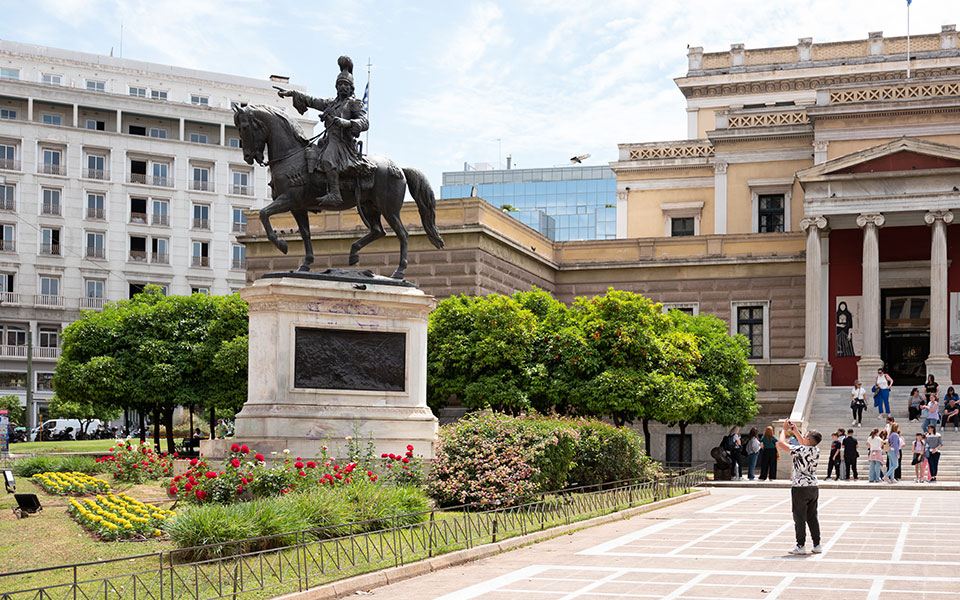
© Vangelis Zavos
Andriantes and runners
The first statues placed in modern Athens, or to be more precise, in the city that emerged after the birth of the Greek state, were of “great men.” For many reasons, these statues continue to dominate numerically in terms of social representation. Among the factors that make them so dominant is their placement in key locations, making it impossible for the eyes of passersby or visitors to avoid them; their size; and, of course, the fact that more and more of them have appeared over time. Studying how the city began erecting such statues (or “andriantes,” from the Greek words for “bravery” and “man”) is of deep political, social and feminist interest. Having said that, most of these statues leave me aesthetically indifferent. However, there is one that stands out to me.
The bronze statue of Theodoros Kolokotronis by Lazaros Sochos was created in the late 19th century. Disciples of urban (and nationalistic) mythology claim that his outstretched right hand is not showing the way to his followers, but rather pointing towards Constantinople. Although not the city’s most popular statue, it is beautiful. Placed in front of the Old Parliament in a small square with benches and flowerbeds, near bus stops and close to large hotels, commercial shops and bars, it has become a de facto part of our daily lives.
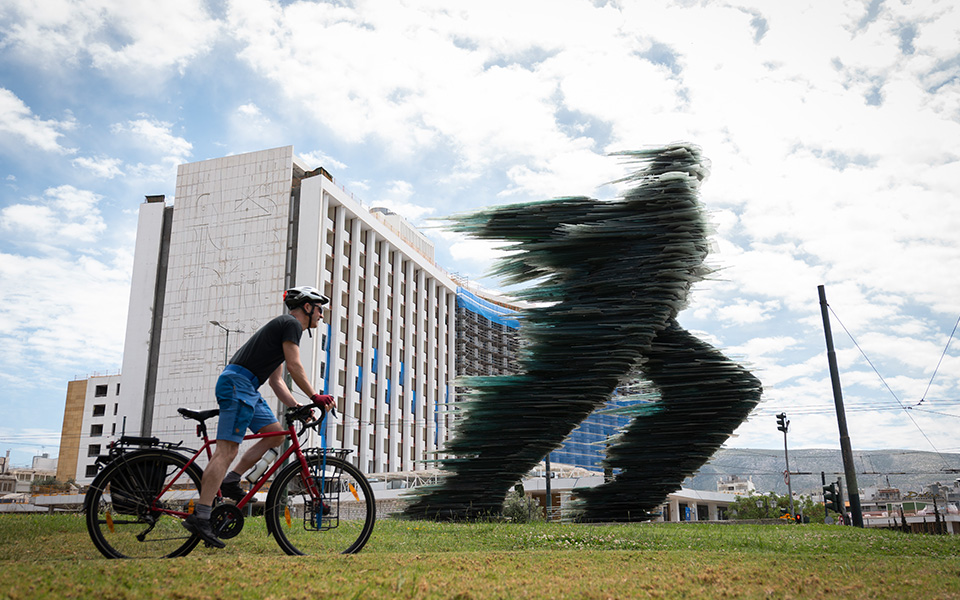
© Vangelis Zavos
However, when I asked around to gauge which was “the most beloved statue of Athenians,” the winner by a large margin was Kostas Varotsos’ “Dromeas” (The Runner). I remember it adorning Omonia Square as far back as the late 1980s, and I also remember its painstaking relocation, pane by glass pane, more than twenty years ago to the green island – not a square, in my opinion – of the Great School of the Nation on Vasileos Konstantinou Avenue, opposite the Hilton and the National Gallery. It is poetically interesting that, almost in its shadow, there now stands a 1,500-year-old olive tree which continues to bear fruit; it is as if these two entities are in dialogue with each other. The relocation of the statue must be considered a success; its new home only strengthened its presence in the everyday lives of Athenians.
The Dromeas was also one of the city’s sculptures that stood out to Mariza Anifanti, an archaeologist and certified tour guide, when I asked her to choose her favorites. “At night, the reflection of the artificial lights on its glass surface abolishes the statue’s stillness. You feel as if it is moving, beyond human endurance, beyond time.”
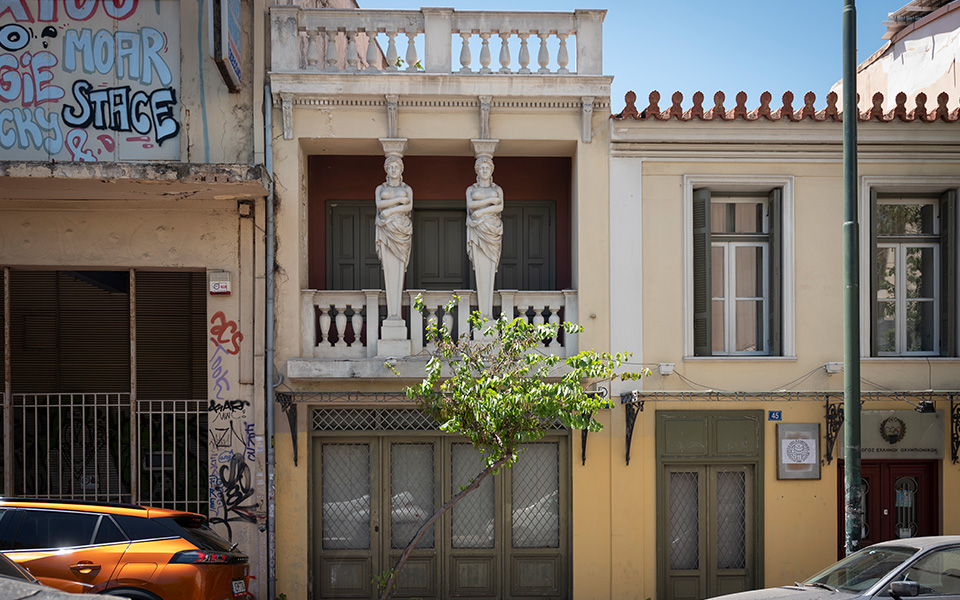
© Vangelis Zavos
The truth is that the night touches all statues with tenderness, giving them a special charm, either by over-illuminating or half-concealing them. It makes them seem as if they indeed have a secret life – within themselves and among each other. And those who gaze upon them might be reminded of folk tales, myths and legends from around the world about people who “turned to stone.” There are also statues that can scare you; the Charioteer (located in the Archaeological Museum of Delphi) always frightens me.
I happened to grow up in a house with many statues of various sizes, as my uncle worked in the “casts” department of the National Archaeological Museum, where exact and officially certified replicas of sculptures were made. Although walks through the halls of what is now my favorite museum left me rather indifferent at the time, the plaster reliefs of the Eleusinian Mysteries, the marble Pericles and the heads of Hygieia scattered around our own living room were part of my life and, in my childhood imagination, conversed with my Playmobile figures. However, the hollow gray-green metal Charioteer copy that we had scared me, with its gaze fixed on something I couldn’t see, its disproportionately sized torso, and its missing arm. In my mind, it was nothing more than a satanic doll which, I feared, would come to life and kill me in the night.
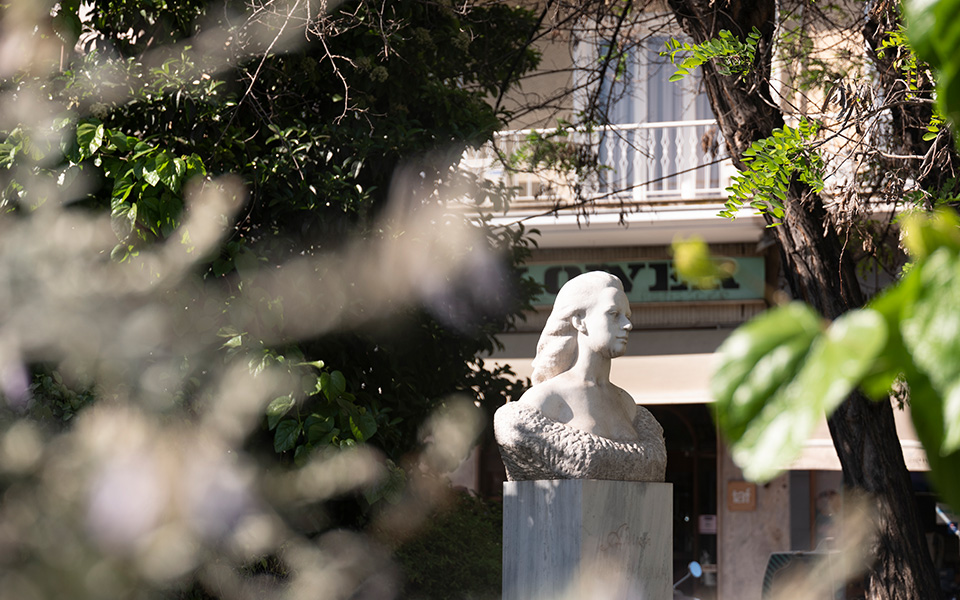
© Vangelis Zavos
Sculptures that provoke
Just as the city was built haphazardly despite efforts at central planning, it seems that the statues were placed within it in a similar manner. Not all of them are commissioned works and nor do they serve a central, national or other narrative through sculpture. Many of the works we admire were accepted as gifts by the Municipality of Athens. There are also recorded instances where subsequent city officials overturned the policies – or rather the decisions – of their predecessors, either due to different tastes or “at the demand of the citizens” when certain sculptures displeased some Athenians due to their “ugliness” or perceived “failure.” Some of these were rescued by the passage of time.
The Dromeas, which so many now like so much, was once accused of “fascist aesthetics,” while almost every – yes, every – attempt to create a statue honoring a woman of significant importance in this country, whether Melina Mercouri, Elli Lambeti, Maria Callas or Aliki Vougiouklaki, is automatically deemed by observers (and non-observers!) of public art as a failure. The bust of Vougiouklaki, a work by Vassilis Dionysopoulos that stands in Mavili Square, has suffered repeated damage and has been removed for repair numerous times.
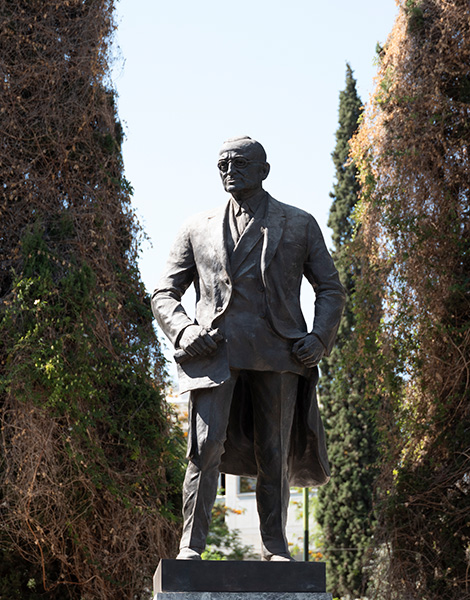
© Vangelis Zavos
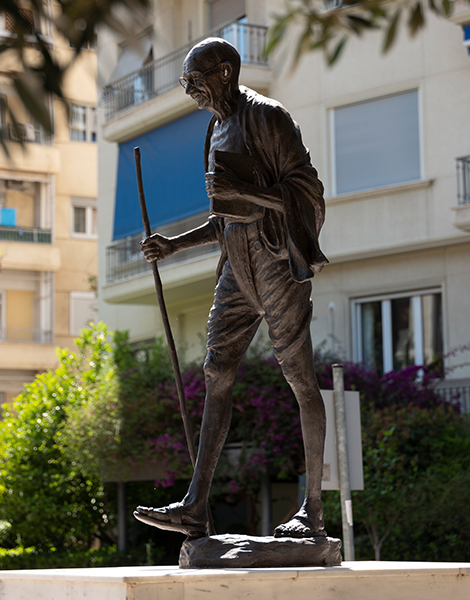
© Vangelis Zavos
The most universally hated sculpture in the city, however, is none other than the much-abused bronze statue of President Harry S. Truman by Felix W. de Weldon, created in the 1960s. It stands, on an elevated platform, just above Vasileos Konstantinou Avenue, a few hundred meters from the Panathenaic Stadium. For years, it was a favorite target of vandals, especially during the years when anti-American sentiment was high, and nearly all protests would end at the American embassy further up the road. These days, things have calmed down.
Close to this statue of the 33rd President of the US now stands the statue of another foreign leader who exercised global influence, Mahatma Gandhi, erected three years ago. It is located in front of the Indian embassy (on Kleanthous Street), which donated it to the city. Regarding vandalism, of course – something to keep the city’s conservators busy – it should be mentioned that even very popular statues, or at least more popular, more “politically innocent” and (let’s be honest) more beautiful than Truman’s, have not escaped vandals who wanted to “have an artistic conversation” with them. Northern Epirus (1951) by Kostas Seferlis, which inspired Kiki Dimoula to write the poem Point of Recognition, was defaced with bright paint before being mutilated and beheaded.
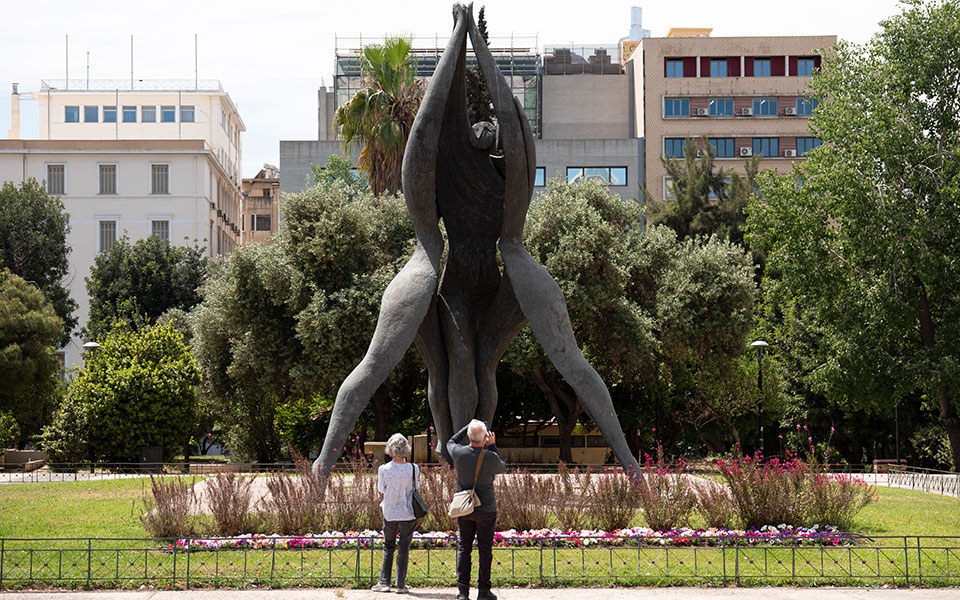
© Vangelis Zavos
I fell in love with a statue
My favorite sculpture is the Monument of National Reconciliation, a work from 1987 by Vasilis Doropoulos, standing in Klafthmonos Square. Although it was intended to have an overt political meaning, I have always been more impressed by its size, line and androgynous physicality. The marble Eros the Archer by Georgios Vroutos, a work from 1896, stands at the other end of the scale size-wise and emerges like a cherub from the tall shrubs of the Zappeion. During the day, it seems innocence personified, but at night it has served as a witness and a landmark for fleeting romantic adventures.
In Plaka, in the era preceding GPS technology, the get-your-bearings landmark par excellence during meandering walks was the Monument of Lysicrates (4th century BC). In truth, however, despite its sculptural, three-dimensional and relief decorations, it’s not exactly a statue. But let’s return to the Zappeion area. Opposite the Panathenaic Stadium stands the Discobolus (Discus Thrower), with which Konstantinos Dimitriadis won the gold medal in sculpture at the 1924 Olympic Games in Paris.
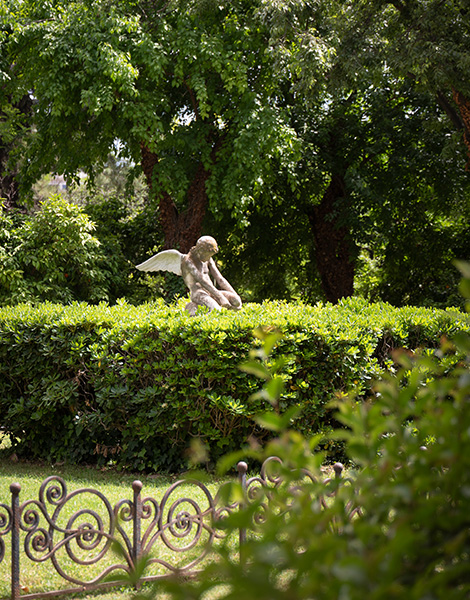
© Vangelis Zavos
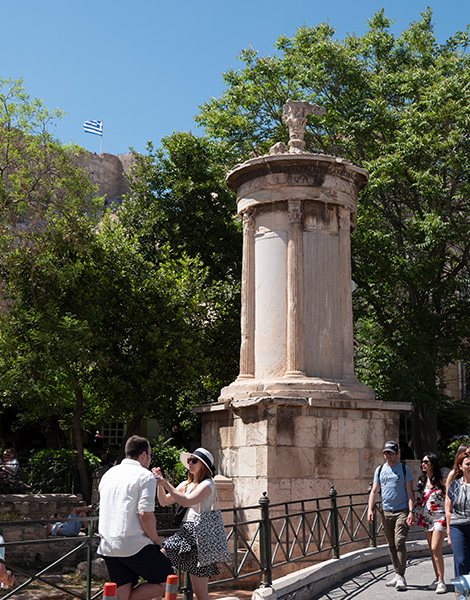
© Vangelis Zavos
When I mention first the Sleeping Female Figure by famed Greek sculptor Yannoulis Chalepas, located in the First Cemetery of Athens, and then the Philopappos Monument to Mariza Anifanti, she says that she puts them in a different category from the city’s other outdoor sculptures. “The Sleeping Female Figure is indeed a statue, but at the same time, it is also a funerary monument, defining the memory of a deceased person, just as a cross would.” The same can be said of the Philopappos Monument, but no matter what category we put it in, what remains of this monument – dating from the early 2nd century AD and constructed as a mausoleum – has helped determine, due to its size, its sculptural decoration and its prominent location high on Filopappou Hill, the way we as residents of this city connect with sculpture in general.
The beloved Caryatids, not those of the Acropolis, but those adorning the balcony of the beautiful house at 45 Aghion Asomaton Street, are not considered to be statues, as they are not freestanding, but rather, part of an architectural structure. What’s more, even though they were originally created for public view, when constructed they were part of a private residence, which now belongs to the Ministry of Culture. This residence gained a prominent significance for a generation or more of Athenians, as it was not only photographed by Henri Cartier-Bresson and painted by Yannis Tsarouchis, but it was also the building that novelist Costas Taktsis chose as a residence for his character Ekavi from his book The Third Wedding.
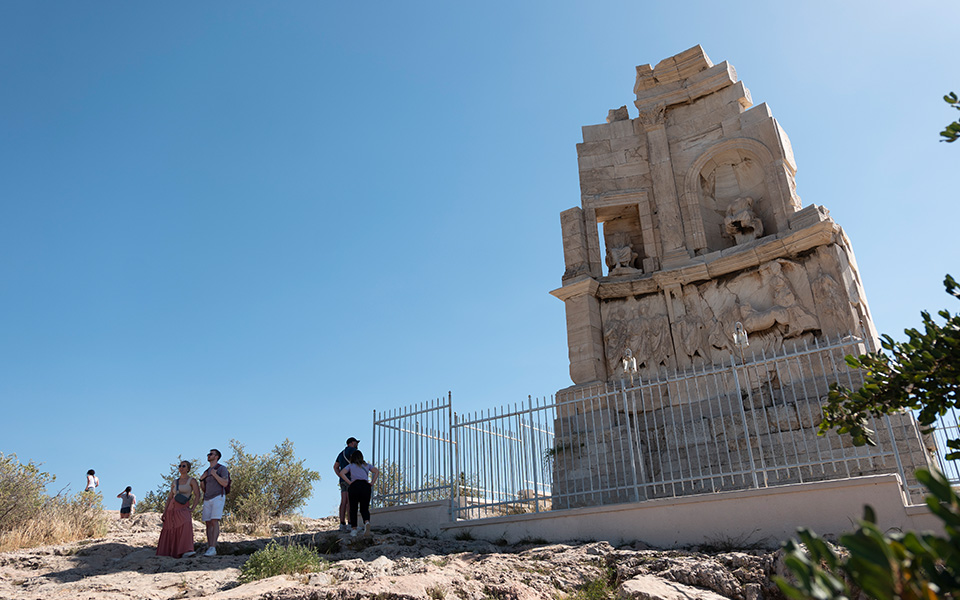
© Vangelis Zavos
How many statues are there in Greece?
The answer to the question “How many statues (it would be more accurate to refer to them as outdoor sculptures) exist in Athens?” is a puzzle. It’s all a matter of definition, which depends, firstly, on whether you are talking about downtown Athens only, the municipality as a whole, or if we open it up to include nearby suburbs. For instance, isn’t George Zongolopoulos’ Umbrellas at Faros in Psychikou a sculpture and a landmark in the everyday lives of Athenians who pass it on Kifissias Avenue? And then, even if we resolve the geographical issue, others emerge. How public are, for example, the monuments and sculptures resting around the marble workshops on Anapafseos Street? What’s more, outdoor art isn’t the only public art. For instance, that category doesn’t include the works of significant contemporary visual artists – Takis, Costas Tsoclis and Chrysa – adorning the covered spaces in metro stations, nor the works in the underground sculpture gallery displaying archaeological finds at the Acropolis metro station.
As if all this wasn’t enough, sometimes the boundaries between public and private are blurred. This is the case with the Caryatids of Aghion Asomaton Street, as well for works in public and private spaces inaccessible to those without a reason for being there, such as the grounds of many hospitals or the main offices of the Piraeus Bank at 4 Amerikis Street, whose windows look out onto Fernando Botero’s The Abduction of Europe.
Still, there’s certainly plenty of statuary to see in the city, and if you’re not already overwhelmed by the many examples on our walk, you’ll find many more sculptures at the National Glyptotheque in Goudi Park, both in the open air and on display in indoor areas (tickets necessary for the latter).












